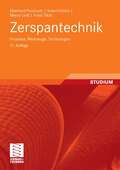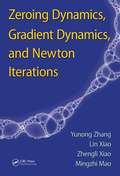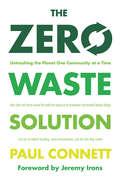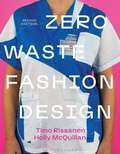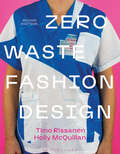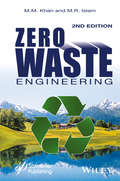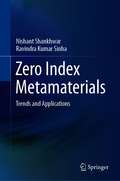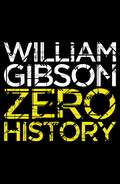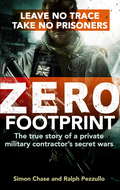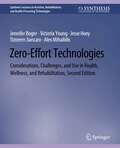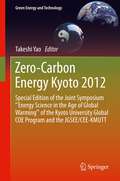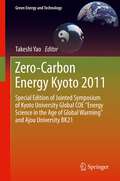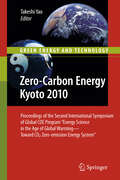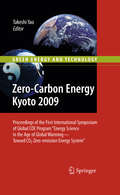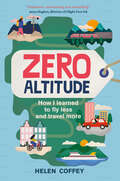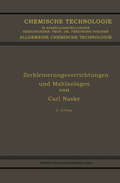- Table View
- List View
Zerspantechnik (Viewegs Fachbücher der Technik)
by Eberhard Paucksch"Zerspantechnik" ist das im deutschen Sprachraum am weitesten verbreitete Lehrbuch über die spangebenden Bearbeitungsverfahren. Es ist mit Hinweisen auf die DIN-Normen und VDI-Richtlinien versehen und enthält Rechenbeispiele mit praktischen Zahlenwerten. Durch regelmäßige Überarbeitung wird es stets auf dem neuesten Stand der Technik und der Normung gehalten. Hinweise auf moderne Werkzeugkonstruktionen, alle notwendigen Formeln für Berechnungen, Entwicklungstendenzen bei allen Bearbeitungsverfahren und Abwandlungen für die Feinbearbeitung sind enthalten.
Zerspantechnik: Prozesse, Werkzeuge, Technologien
by Eberhard Paucksch Sven Holsten Marco Linß Franz TikalDieses Lehr- und Übungsbuch vermittelt dem Studierenden anschaulich die allgemeinen, physikalisch technischen Grundlagen der Zerspanungstechnik. Das Buch umfasst das gesamte Gebiet der spanenden Fertigung mit den verschiedenen Fertigungsverfahren und beschreibt verfahrenstypische Merkmale. Die heutzutage immer bedeutsameren Randbedingungen in einem Zerspanungsprozess und deren Wechselwirkungen sowie weiterführende Aspekte dieser Technologie werden dargestellt. Praktische Übungsbeispiele helfen den Stoff zu vertiefen. In der aktuellen neu strukturierten und vollständig überarbeiteten Auflage wurden wesentliche dem Stand der Technik entsprechende Neuerungen aufgenommen, beispielsweise die numerische Zerspanungsanlyse und Schneidkantenpräparation.
Zerspantechnik: Teil III: Schleifen, Honen, Verzahnverfahren, Zerspankennwerte, Wirtschaftlichkeit (wt Weiterbildung Technik #5)
by H. Victor M. Müller R. OpferkuchZerspankraft, Werkzeugbeanspruchung und Verschleiß beim Fräsen mit Hartmetall (WBK-Forschungsberichte aus dem Institut für Werkzeugmaschinen und Betriebstechnik der Universität Karlsruhe #6)
by M. MüllerZerspanbarkeit hochwarmfester und nichtrostender Stähle (Forschungsberichte des Wirtschafts- und Verkehrsministeriums Nordrhein-Westfalen)
by Herwart Opitz Heinrich Axer Helmut RohdeZeroing Dynamics, Gradient Dynamics, and Newton Iterations
by Yunong Zhang Lin Xiao Zhengli Xiao Mingzhi MaoNeural networks and neural dynamics are powerful approaches for the online solution of mathematical problems arising in many areas of science, engineering, and business. Compared with conventional gradient neural networks that only deal with static problems of constant coefficient matrices and vectors, the authors’ new method called zeroing dynamics solves time-varying problems. Zeroing Dynamics, Gradient Dynamics, and Newton Iterations is the first book that shows how to accurately and efficiently solve time-varying problems in real-time or online using continuous- or discrete-time zeroing dynamics. The book brings together research in the developing fields of neural networks, neural dynamics, computer mathematics, numerical algorithms, time-varying computation and optimization, simulation and modeling, analog and digital hardware, and fractals. The authors provide a comprehensive treatment of the theory of both static and dynamic neural networks. Readers will discover how novel theoretical results have been successfully applied to many practical problems. The authors develop, analyze, model, simulate, and compare zeroing dynamics models for the online solution of numerous time-varying problems, such as root finding, nonlinear equation solving, matrix inversion, matrix square root finding, quadratic optimization, and inequality solving.
The Zero Waste Solution: Untrashing the Planet One Community at a Time
by Paul Connett Jeremy IronsWaste is something we all make every day but often pay little attention to. That's changing, and model programs around the globe show the many different ways a community can strive for, and achieve, zero-waste status. Scientist-turned-activist Paul Connett, a leading international figure in decades-long battles to fight pollution, has championed efforts to curtail overconsumption and keep industrial toxins out of our air and drinking water and bodies. But he’s best known around the world for leading efforts to help communities deal with their waste in sustainable ways—in other words, to eliminate and reuse waste rather than burn it or stow it away in landfills. In The Zero Waste Solution, Connett profiles the most successful zero-waste initiatives around the world, showing activists, planners, and entrepreneurs how to re-envision their community’s waste-handling process—by consuming less, turning organic waste into compost, recycling, reusing other waste, demanding nonwasteful product design, and creating jobs and bringing community members together in the process. The book also exposes the greenwashing behind renewed efforts to promote waste incinerators as safe, nontoxic energy suppliers, and gives detailed information on how communities can battle incineration projects that, even at their best, emit dangerous particles into the atmosphere, many of which remain unregulated or poorly regulated. An important toolkit for anyone interested in creating sustainable communities, generating secure local jobs, and keeping toxic alternatives at bay.
Zero Waste Fashion Design (Required Reading Range Ser.)
by Timo Rissanen Holly McQuillanZero Waste Fashion Design combines practical examples, flat patterns and more than 20 exercises to help you incorporate this sustainable technique into your portfolio. There are also beautifully illustrated interviews with innovative designers, including Richard Lindgvist, Mary Beth Bentaha and Daniel Desanto to show how sustainable practice continues to evolve within industry.Industry pioneers, Timo Rissanen and Holly McQuillan, offer flexible strategies and easy-to-master zero waste techniques to help you develop your own cutting-edge fashion designs. This updated edition includes new content on integrating 3D design into a zero waste process, additional coverage of the historical context of zero waste around the world, and expands on the related technique of subtraction cutting to make this the ultimate practical guide to sustainable fashion design.
Zero Waste Fashion Design
by Timo Rissanen Holly McQuillanZero Waste Fashion Design combines practical examples, flat patterns and more than 20 exercises to help you incorporate this sustainable technique into your portfolio. There are also beautifully illustrated interviews with innovative designers, including Richard Lindgvist, Mary Beth Bentaha and Daniel Desanto to show how sustainable practice continues to evolve within industry.Industry pioneers, Timo Rissanen and Holly McQuillan, offer flexible strategies and easy-to-master zero waste techniques to help you develop your own cutting-edge fashion designs. This updated edition includes new content on integrating 3D design into a zero waste process, additional coverage of the historical context of zero waste around the world, and expands on the related technique of subtraction cutting to make this the ultimate practical guide to sustainable fashion design.
Zero Waste Engineering: A New Era of Sustainable Technology Development (Wiley-Scrivener #82)
by M. M. Khan M. R. IslamIs "zero waste engineering" possible? This book outlines how to achieve zero waste engineering, following natural pathways that are truly sustainable. Using methods that have been developed in various areas for sustainability purposes, such as new mathematical models, recyclable material selection, and renewable energy, the authors probe the principles of zero waste engineering and how it can be applied to construction, energy production, and many other areas of engineering. This groundbreaking new volume: Explores new scientific principles on which sustainability and zero waste engineering can be based Presents new models for energy efficiency, cooling processes, and natural chemical and material selection in industrial applications and business Explains how "green buildings" and "green homes" can be efficiently built and operated with zero waste Offers case histories and successful experiments in sustainability and zero-waste engineering Ideal for: Engineers and scientists of all industries, including the energy industry, construction, the process industries, and manufacturing. Chemical engineers, mechanical engineers, electrical engineers, petroleum engineers, process engineers, civil engineers, and many other types of engineers would all benefit from reading this exciting new volume.
Zero Waste Engineering: A New Era of Sustainable Technology Development (Wiley-Scrivener)
by M. M. Khan M. R. IslamIs "zero waste engineering" possible? This book outlines how to achieve zero waste engineering, following natural pathways that are truly sustainable. Using methods that have been developed in various areas for sustainability purposes, such as new mathematical models, recyclable material selection, and renewable energy, the authors probe the principles of zero waste engineering and how it can be applied to construction, energy production, and many other areas of engineering. This groundbreaking new volume: Explores new scientific principles on which sustainability and zero waste engineering can be based Presents new models for energy efficiency, cooling processes, and natural chemical and material selection in industrial applications and business Explains how "green buildings" and "green homes" can be efficiently built and operated with zero waste Offers case histories and successful experiments in sustainability and zero-waste engineering Ideal for: Engineers and scientists of all industries, including the energy industry, construction, the process industries, and manufacturing. Chemical engineers, mechanical engineers, electrical engineers, petroleum engineers, process engineers, civil engineers, and many other types of engineers would all benefit from reading this exciting new volume.
Zero Waste: Management Practices for Environmental Sustainability
by Ashok K. RathoureZero Waste: Management Practices for Environmental Sustainability presents approaches for resource management centered on reducing waste and reusing and recycling materials. It aims to save energy by reducing energy consumption associated with extracting, processing, and transporting raw materials and waste, and also to reduce and eventually eliminate the need for landfills and incinerators. This book presents the various principles, methods, and tools that can be used to address different issues in the areas of industrial waste reduction and sustainability. It examines how to eliminate waste at the source and at all points of a supply chain, and how to shift from the current one-way linear resource model to a sustainable "closed-loop" system. Proposes strategies for businesses to reduce and reuse waste with a goal of reaching a zero waste status. Focuses on how mitigating waste and promoting recycling can save vast amounts of energy. Explains how the zero waste approach would be a key measure to ensure environmental sustainability and help to offset global climate change.
Zero Waste: Management Practices for Environmental Sustainability
by Ashok K. RathoureZero Waste: Management Practices for Environmental Sustainability presents approaches for resource management centered on reducing waste and reusing and recycling materials. It aims to save energy by reducing energy consumption associated with extracting, processing, and transporting raw materials and waste, and also to reduce and eventually eliminate the need for landfills and incinerators. This book presents the various principles, methods, and tools that can be used to address different issues in the areas of industrial waste reduction and sustainability. It examines how to eliminate waste at the source and at all points of a supply chain, and how to shift from the current one-way linear resource model to a sustainable "closed-loop" system. Proposes strategies for businesses to reduce and reuse waste with a goal of reaching a zero waste status. Focuses on how mitigating waste and promoting recycling can save vast amounts of energy. Explains how the zero waste approach would be a key measure to ensure environmental sustainability and help to offset global climate change.
Zero Index Metamaterials: Trends and Applications
by Nishant Shankhwar Ravindra Kumar SinhaThis book presents the emerging regime of zero refractive index photonics, involving metamaterials that exhibit effectively zero refractive index. Metamaterials are artificial structures whose optical properties can be tailored at will. With metamaterials, intriguing and spellbinding phenomena like negative refraction and electromagnetic cloaking could be realized, which otherwise seem unnatural or straight out of science fiction. Zero index metamaterials are also seen as a means of boosting nonlinear properties and are believed to have strong prospects for being useful in nonlinear optical applications. In summary, this book highlights almost everything currently available on zero index metamaterials and is useful for professionally interested and motivated readers.
Zero History: A stylish, gripping technothriller from the multi-million copy bestselling author of Neuromancer (Blue Ant #3)
by William Gibson'Gibson is having tremendous fun' Independent--------------THE THIRD NOVEL IN THE BLUE ANT TRILIOGY - READ PATTERN RECOGNITION AND SPOOK COUNTRY FOR MOREHubertus Bigend, the Machiavellian head of global ad-agency Blue Ant, wants to uncover the maker of an obscurely fashionable denim that is taking subculture by storm. Ex-musician Henry Hollis knows nothing about fashion, but Bigend decides she is the woman for the job anyway.Soon, though, it becomes clear that Bigend's interest in underground labels might have sinister applications. Powerful parties, who'll do anything to get what they want, are showing their hand. And Hollis is about to find herself in the crossfire.A gripping spy thriller by William Gibson, bestselling author of Neuromancer. Part prophesy, part satire, Zero History skewers the absurdity of modern life with the lightest and most engaging of touches. Readers of Neal Stephenson, Ray Bradbury and Iain M. Banks won't be able to put this book down.--------------'An ideas-swarm, coated with a hipster glaze' Herald'Gibson's writing is thrillingly tight' New York Times Book Review
Zero Footprint: The true story of a private military contractor’s secret wars in the world’s most dangerous places
by Simon ChaseSimon Chase's life is a maze of burner phones, encrypted emails, secret meetings, and weaponry - all devoted to executing missions too sensitive for government acknowledgement. Working for shadowy British and American organisations, Chase has been on the trail of Bin Laden in Afghanistan, protected allied generals in Iraq, and been part of an operation directly related to the attack in 2012 on the US consulate in Benghazi.Zero Footprint takes us to this dangerous and thrilling world, and tells the true story of a private military contractor whose work forms the foundation for western security abroad, especially when the UK and US military, intelligence agencies, and departments of state need something done that they can't - or won't - do themselves.
Zero-Effort Technologies: Considerations, Challenges, and Use in Health, Wellness, and Rehabilitation, Second Edition (Synthesis Lectures on Assistive, Rehabilitative, and Health-Preserving Technologies)
by Jennifer Boger Victoria Young Jesse Hoey Tizneem Jiancaro Alex MihailidisThis book introduces zero-effort technologies (ZETs), an emerging class of technologies that require little or no effort from the people who use them. ZETs use advanced computing techniques, such as computer vision, sensor fusion, decision-making and planning, machine learning, and the Internet of Things to autonomously perform the collection, analysis, and application of data about the user and/or his/her context. This book begins with an overview of ZETs, then presents concepts related to their development, including pervasive intelligent technologies and environments, design principles, and considerations regarding use. The book discusses select examples of the latest in ZET development before concluding with thoughts regarding future directions of the field.
Zero Effort Technologies: Considerations, Challenges, and Use in Health, Wellness, and Rehabilitation (Synthesis Lectures on Technology and Health)
by Alex Mihailidis Jennifer Boger Jesse Hoey Tizneem JiancaroThis book introduces zero-effort technologies (ZETs), an emerging class of technology that requires little or no effort from the people who use it. ZETs use advanced techniques, such as computer vision, sensor fusion, decision-making and planning, and machine learning to autonomously operate through the collection, analysis, and application of data about the user and his/her context. This book gives an overview of ZETs, presents concepts in the development of pervasive intelligent technologies and environments for health and rehabilitation, along with an in-depth discussion of the design principles that this approach entails. The book concludes with a discussion of specific ZETs that have applied these design principles with the goal of ensuring the safety and well-being of the people who use them, such as older adults with dementia and provides thoughts regarding future directions of the field. Table of Contents: Lecture Overview / Introduction to Zero Effort Technologies / Designing ZETs / Building and Evaluating ZETs / Examples of ZETs / Conclusions and Future Directions
Zero-Carbon Energy Kyoto 2012: Special Edition of the Joint Symposium "Energy Science in the Age of Global Warming" of the Kyoto University Global COE Program and the JGSEE/CEE-KMUTT (Green Energy and Technology)
by Takeshi YaoThe Global COE is setting out a zero-emission technology roadmap and is promoting socioeconomic studies of energy, studies of new technologies for renewable energies, and research for advanced nuclear energy. It has also established the Global COE Unit for Energy Science Education to support young researchers as they apply their skills and knowledge and a broad international perspective to respond to issues of energy and the environment in our societies. This book follows on the earlier volumes Zero-Carbon Energy Kyoto 2009, 2010, and 2011.
Zero-Carbon Energy Kyoto 2011: Special Edition of Jointed Symposium of Kyoto University Global COE "Energy Science in the Age of Global Warming" and Ajou University BK21 (Green Energy and Technology)
by Takeshi YaoSince 2008, the Global Center of Excellence (COE) at Kyoto University, Japan, has been engaged in a program called “Energy Science in the Age of Global Warming—Toward a CO2 Zero-Emission Energy System.” Its aim is to establish an international education and research platform to foster educators, researchers, and policy makers who can develop technologies and propose policies for establishing a CO2 zero-emission society no longer dependent on fossil fuels. It is well known that the energy problem cannot simply be labeled a technological one, as it is also deeply involved with social and economic issues. The establishment of a “low-carbon energy science” as an interdisciplinary field integrating social sciences with natural sciences is necessary. The Global COE is setting out a zero-emission technology roadmap and is promoting socioeconomic studies of energy, studies of new technologies for renewable energies, and research for advanced nuclear energy. It has also established the Global COE Unit for Energy Science Education to support young researchers as they apply their skills and knowledge and a broad international perspective to respond to issues of energy and the environment in our societies. Comprising the proceedings of the Third International Symposium of the Global COE Program, this book follows on the earlier volumes Zero-Carbon Energy Kyoto 2009 and 2010, published in March 2010 and February 2011, respectively.
Zero-Carbon Energy Kyoto 2010: Proceedings of the Second International Symposium of Global COE Program "Energy Science in the Age of Global Warming—Toward CO2 Zero-emission Energy System" (Green Energy and Technology)
by Takeshi YaoSince 2008, the Global Center of Excellence (COE) at Kyoto University, Japan, has been engaged in a program called “Energy Science in the Age of Global Warming—Toward a CO2 Zero-Emission Energy System.” Its aim is to establish an international education and research platform to foster educators, researchers, and policy makers who can develop technologies and propose policies for establishing a CO2 zero-emission society no longer dependent on fossil fuels. It is well known that the energy problem cannot simply be labeled a technological one, as it is also deeply involved with social and economic issues. The establishment of a “low-carbon energy science” as an interdisciplinary field integrating social sciences with natural sciences is necessary. The Global COE is setting out a zero-emission technology roadmap and is promoting socioeconomic studies of energy, studies of new technologies for renewable energies, and research for advanced nuclear energy. It has also established the Global COE Unit for Energy Science Education to support young researchers as they apply their skills and knowledge and a broad international perspective to respond to issues of energy and the environment in our societies. Comprising the proceedings of the Second International Symposium of the Global COE Program, this book follows on the earlier volume Zero-Carbon Energy Kyoto 2009, published in March 2010.
Zero-Carbon Energy Kyoto 2009: Proceedings of the First International Symposium of Global COE Program "Energy Science in the Age of Global Warming - Toward CO2 Zero-emission Energy System" (Green Energy and Technology)
by Takeshi YaoEmissions of CO2 have come to be regarded as the main factor in climate change in recent years, and how to control them has become a pressing issue. The problem cannot simply be labeled a technological one, however, because it is deeply involved with social and economic issues. Since 2008, the Global Center of Excellence (COE) program titled “Energy Science in the Age of Global Warming—Toward a CO2 Zero-Emission Energy System” has been held at Kyoto University, Japan. The program aims to establish an international education and research platform to foster educators, researchers, and policy makers who can develop technologies and propose policies toward a zero-emission society by the year 2100. Setting out a zero-emission technology roadmap, Global COE promotes socioeconomic studies of energy, the study of new technologies for renewable energies, and research in advanced nuclear energy. A compilation of the lectures and presentations from the first symposium of Global COE held at Kyoto University, this book is intended to provide the impetus for the establishment of low carbon energy science to bring about harmony between mankind and the environment.
Zero Altitude: How I Learned to Fly Less and Travel More
by Helen CoffeyIn recent decades, private jets have become status symbols for the world’s wealthiest, while quick and easy flights have brought far-flung destinations within the reach of everyone. But at what cost to the environment? Around the world, flying emits around 860 million metric tonnes of carbon dioxide each year, and until the outbreak of Covid-19, the aviation industry was one of the planet’s fastest-growing polluters. Now is the perfect time to pause and take stock of our toxic relationship with flying. Part climate-change investigation, part travel memoir, Zero Altitude follows Helen Coffey as she journeys as far as she can in the course of her job as a top travel journalist – all without getting on a single flight. Between trips by train, car, boat and bike, she meets climate experts and activists at the forefront of the burgeoning flight-free movement. Over the course of her travels, she discovers that keeping both feet on the ground is not only possible but that it can be an exhilarating opportunity for adventure. Her book is brimming with tips and ideas for swapping the middle seat for the open road.
Zerkleinerungsvorrichtungen und Mahlanlagen (Chemische Technologie in Einzeldarstellungen)
by Carl NaskeDieser Buchtitel ist Teil des Digitalisierungsprojekts Springer Book Archives mit Publikationen, die seit den Anfängen des Verlags von 1842 erschienen sind. Der Verlag stellt mit diesem Archiv Quellen für die historische wie auch die disziplingeschichtliche Forschung zur Verfügung, die jeweils im historischen Kontext betrachtet werden müssen. Dieser Titel erschien in der Zeit vor 1945 und wird daher in seiner zeittypischen politisch-ideologischen Ausrichtung vom Verlag nicht beworben.
Zerkleinerungs-Vorrichtungen und Mahlanlagen (Chemische Technologie in Einzeldarstellungen)
by Carl NaskeDieser Buchtitel ist Teil des Digitalisierungsprojekts Springer Book Archives mit Publikationen, die seit den Anfängen des Verlags von 1842 erschienen sind. Der Verlag stellt mit diesem Archiv Quellen für die historische wie auch die disziplingeschichtliche Forschung zur Verfügung, die jeweils im historischen Kontext betrachtet werden müssen. Dieser Titel erschien in der Zeit vor 1945 und wird daher in seiner zeittypischen politisch-ideologischen Ausrichtung vom Verlag nicht beworben.

